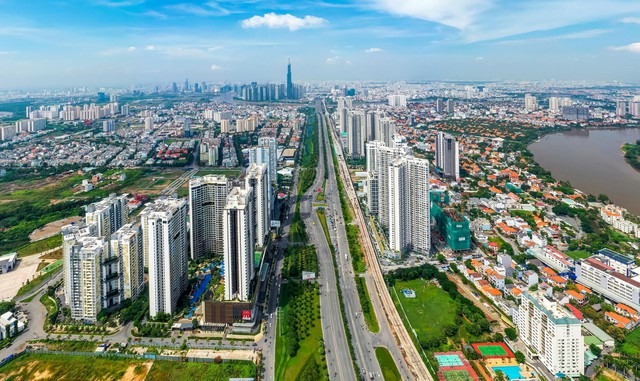Capital targets to raise urbanization rate to 75 percent by 2030
VGP - The capital city of Ha Noi is striving to increase its urbanization rate to 60-62 percent by 2025 and around 65-75 percent by 2030.

Illustration photo
The objectives are parts of an action program issued by the municipal Party Committee that outlines its efforts to implement the Politburo's Resolution No.06-NQ/TW, dated January 24, 2022, on the planning, construction, management, and sustainable development of urban areas in Viet Nam to 2030, with a vision to 2045.
The program also targets are to expand the urban construction area to about 30 percent of the total natural land area by 2025 and 33-36 percent by 2030.
The city plans to complete the planning of all districts and satellite urban areas, as well as concrete planning for renovation and reconstruction of old apartment buildings.
The city will invest in building new hospitals, with priority given to the early completion of construction on four large general hospitals at the gateways of the capital city, and fulfilling the target of 30-35 beds per 10,000 people by 2025.
The municipal People's Committee will strive for the average GRDP growth rate in the 2021 - 2025 period to be higher than the country's average, GRDP in the 2026 - 2030 period to increase by 8.0 - 8.5 percent a year, and per capita GRDP of VND 12,000 - 13,000. The proportion of processing and manufacturing in the GRDP will be 17 percent by 2025, 20 percent by 2030; and digital economy 25-30 percent by 2025 and 35-40 percent by 2030.
Ha Noi also targets urban construction land as a proportion of the overall natural land set at about 30 percent by 2025, with hopes to attain between 33-36 percent by 2030. These details will be further scrutinized during the formulation of the Ha Noi Capital Plan, the adjustment of the General Plan for Hanoi Capital, and the city's Urban Development Program.
By 2025, Ha Noi plans to finalize all district-level construction planning, zoning of satellite urban areas, functional zone developments, detailed plans for refurbishment regions, regeneration of dated flat complexes, and urban development schemes across the city. This encompasses the introduction of an all-encompassing set of guidelines and standards linked to planning and architecture. It also involves making necessary planning adjustments to facilitate the evolution of districts into urban districts.
The city is also committed to reaching a transport land ratio over urban construction land (inclusive of static transport) of 12-15% by 2025 and 15-20 percent by 2030. The rate of public transport users is set to be about 30-35 percent by 2025, and 45-50 percent by 2030. The anticipated average green space per urban dweller is projected to be around 7.8-8.1sq.m per individual by 2025 and approximately 12-14 sq.m per individual by 2030. The mean housing floor space per person in urban regions is slated to achieve 31sq.m per individual by 2025 and 33sq.m by 2030.
Ha Noi aims to refurbish, enhance, and finance the establishment of new hospitals. Priority is given to the swift completion of four major general hospitals situated at the city's entrances, with an objective of offering 30-35 beds per thousand inhabitants by 2025.
The ambition is to elevate the aggregate count of hospital beds in medical facilities (within specialist healthcare centers and assorted hospital tiers) to about 21,880 beds by 2025 and approximately 24,380 beds by 2030. The objective is to achieve a hospital bed ratio for urban healthcare institutions of 2.8 per 1,000 individuals by 2025, and 3.2 by 2030, maintaining at least 15 doctors for every 10,000 individuals. This is paired with human resources development to guarantee effective management post-investment completion.
The city has ambitions to finalize the Belt Road 4 by 2027 and is laying down investment plans for the Belt Road 5 to be initiated before 2030./.

